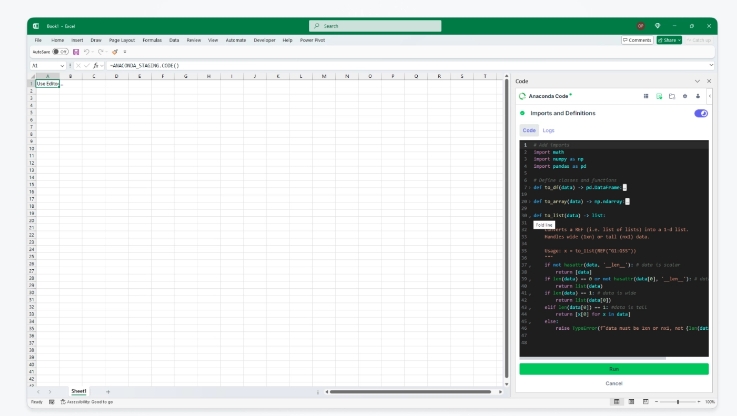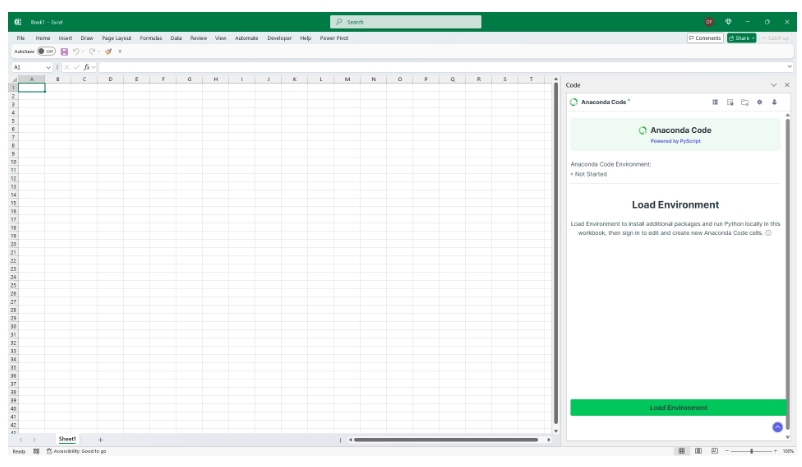Anaconda 代码:通过 Python 创建和使用 Excel 的用户定义函数
 常见问题
常见问题  admin
admin  发布时间:2024-12-30
发布时间:2024-12-30  浏览:67 次
浏览:67 次 我们很高兴地宣布 Anaconda 代码中的一项强大的新功能:Python 用户定义函数!借助 UDF,您可以编写 Python 函数并像本机 Excel 函数一样使用它们,将 Python 丰富的数据科学生态系统的全部功能直接带入您的电子表格公式中。让我们看一个真实的示例,展示这种集成的强大功能。
在一个函数调用中从交叉表到长格式
考虑一个常见的数据重塑挑战:将交叉表(宽)数据转换为长格式。您可能会想,“好吧,我可以使用 Power Query 做到这一点,没有问题。”是的,确实如此。但生成的表不是动态的。每次输入数据发生变化时,都需要刷新查询。并且该查询与该工作簿相关联。使用 Anaconda Code 和 Anaconda Toolbox,您可以创建 Python UDF,将其另存为代码片段,并在您打开的任何工作簿中使用它。另外,快速逆透视宽格式表所需的代码非常简单。以下是创建自定义 UNPIVOT 函数的方法,该函数的工作方式与任何内置 Excel 函数一样:
Python
# decorate the function with the UDF decorator
@UDF(name='UNPIVOT', nested=False)
def unpivot_data(
data: UDF.Range, # the input data from the Excel sheet
id_vars, # the column(s) to keep fixed in the output
var_name='variable', # the column name to hold the unpivoted column headers
value_name='value' # the column name to hold the unpivoted values
) -> UDF.Range: # output the result as an Excel spilled array
# convert the input data into a Pandas DataFrame
df = to_df(data)
# pass the arguments through to the melt function and return the result
return df.melt(id_vars=id_vars, var_name=var_name, value_name=value_name)
定义后,您可以直接在 Excel 中使用该函数。例如,销售数据分布在各个年份:
Anaconda 代码:通过 Python 创建和使用 Excel 的用户定义函数插图

图 1:直接从 Excel 网格调用 UNPIVOT 用户定义函数
如果您想遵循此示例,这里有一个公式可以为您提供输入数据。只需将其放入工作表的单元格 B2 中即可。
={"Category",1996,1997,1998;"Confections",29685.549981647,82657.7504128219,55013.9244483569;"Dairy Products",40980.4499421209,115387.639834883,78139.194964755;"Meat/Poultry",28813.6599777699,80975.1079431361,53233.591471141}
设置输入数据后,打开 Anaconda Code 并加载环境。这将确保 Python 环境在加载项中运行:
Anaconda 代码:通过 Python 创建和使用 Excel 的用户定义函数插图1

图2:要在Anaconda代码中使用Python,首先需要加载环境
加载环境后,转到Anaconda Code 的Imports and Definitions选项卡,并将代码片段中的 UDF 代码粘贴到脚本中。作为参考,这里再次说明:
# decorate the function with the UDF decorator
@UDF(name='UNPIVOT', nested=False)
def unpivot_data(
data: UDF.Range, # the input data from the Excel sheet
id_vars, # the column(s) to keep fixed in the output
var_name='variable', # the column name to hold the unpivoted column headers
value_name='value' # the column name to hold the unpivoted values
) -> UDF.Range: # output the result as an Excel spilled array
# convert the input data into a Pandas DataFrame
df = to_df(data)
# pass the arguments through to the melt function and return the result
return df.melt(id_vars=id_vars, var_name=var_name, value_name=value_name)
将其粘贴到“导入和定义”脚本中后,单击“保存并运行”按钮以在 Excel 中注册 UNPIVOT 函数。
完成后,绿色的“保存并运行”按钮将更改为“运行”。这意味着您的函数现已在 Excel 中注册。!继续使用它来逆透视销售数据!
=UNPIVOT(B2:E5,"Category", "Year", "Revenue")
现在您已经了解了如何在 Anaconda 代码中创建 Python 用户定义函数,这里有一个快速视频,展示了一个更复杂的示例。希望这会激发您对使用此新功能可以做的事情的一些想法。
为什么 Anaconda 代码中的 UDF 会改变游戏规则
原生 Excel 集成:您的 Python 函数就像内置 Excel 函数一样工作
范围支持:使用 UDF.Range 类型提示自然地处理 Excel 范围
灵活的参数:支持可变参数和带有默认值的可选参数
内置文档:您的 Python 文档字符串成为 Excel 函数帮助文本
本地执行:函数在安全的 Anaconda 代码环境中本地运行
UDF 入门
创建您自己的 UDF 就像使用 @UDF 修饰 Python 函数一样简单。以下是它们的特别之处:
Excel 范围的类型提示:使用 UDF.Range 处理单元格范围
可选参数:添加默认值以使函数参数在 Excel 中可选
有用的文档:添加文档字符串为 Excel 用户提供功能帮助
变量参数:支持 *args 接受多个输入
立即开始创建您自己的函数
可能性是无限的 – 从简单的数据转换到复杂的统计分析,您现在可以将 Python 的功能直接引入 Excel 公式中。


 售前咨询专员
售前咨询专员